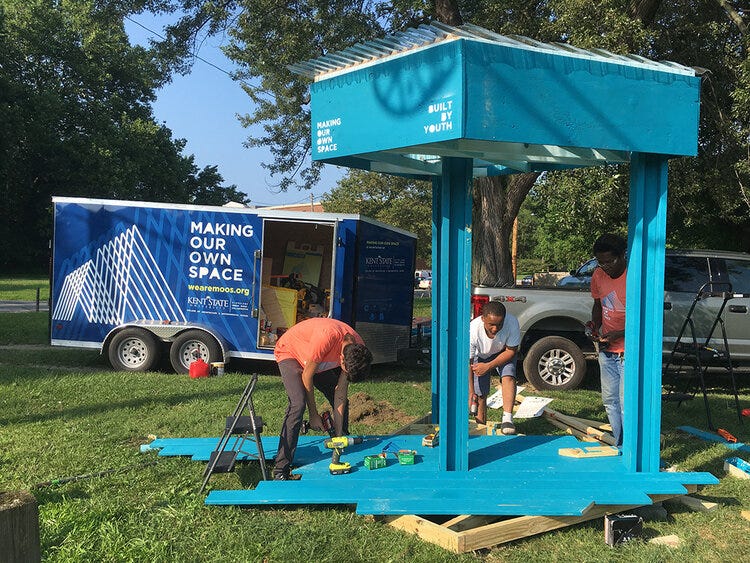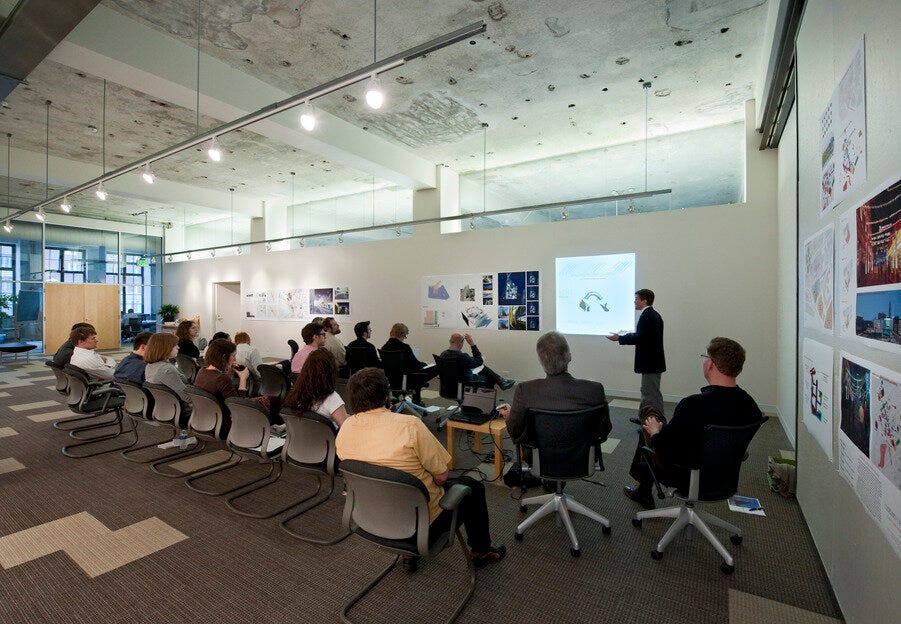As many modalities as we can: a conversation with Terry Schwarz, FAICP
Topics include: the CUDC’s approach to community engagement, the pandemic's impact on the process, collaborating w/ younger generations, and educating to-be designers.
Last semester, as a student at Kent State University’s CAED doing research on Cleveland’s revitalization projects, I had the honor of speaking with Terry Schwarz, FAICP, director of the Cleveland Urban Design Collaborative (CUDC). True to this semester’s theme—Lived—the interview answers questions (and asks even more) about who gets to Live in our designs, who doesn’t, and who gets to decide. Read more about Schwarz at the end of the interview.
I’ve edited the interview for relevancy, length, and clarity. I’ve also linked some of the things we were talking about in the text.
Sam Clemente: I wanted to start by talking about the CUDC’s role in taking suggestions from a neighborhood’s residents. What was that process like?
Terry Schwarz: Yeah for sure, that’s pretty much what we do. In Lee-Harvard, it was mostly a series of workshops. But, in many community design and planning projects, it's usually 3 points of contact, if not more. That first one is really the ‘getting to know you’ conversation. “What are we trying to accomplish here?” “What does the previous plan look like?” Then there’s a lot of fieldwork. When you’re out in the neighborhood with a camera and a clipboard, people come and talk to you and you can have lots of informal input. By the time we come back to the second meeting, we try to come back with alternatives. It’s never a good idea to be like “here it is” or “here’s what you asked for,” but rather, “we heard you say this.”
Clemente: And then there’s the discussion of who we’re really engaging with—who’s in the room and who’s not. Is there any specific approach you’ve found for this?
“We don’t want to miss anybody because of a choice that we made about how to communicate.”
Schwarz: It depends on the project, right? There’s a bunch of tools now that we didn’t have when I started here. There’s a tool called coUrbanize that Ohio City, Detroit Shoreway, and Tremont use a lot. So, if you can’t gather everybody in a room to talk about things, you have this online platform where developers submit their drawings and let people respond to them. coUrbanize is a great tool assuming that people have access to computers and the internet, which you can’t always assume in Cleveland. About 30% of households in the city don’t have any fixed internet access. So sometimes, with certain populations, you really just have to show up and have a conversation. Whenever we do a project, we try to touch on as many modalities as we can. We don’t want to miss anybody because of a choice that we made about how to communicate.

Another one of the tools that we find really effective is our youth program called “Making Our Own Space” (MOOS). In that case, young people are actually part of a team that envisions improvements to their neighborhoods. Youth engagement can be super helpful because young people are usually not in the room of a traditional planning process. But, if you’re planning long term, their voices are really important.
Clemente: You mentioned the Lee-Harvard plans, and I saw that they used a lot of analog methods—fliers and in-person meetings—since a majority of the residents are elderly. But when I spoke with the project’s redevelopment strategist, she said they didn’t reach as much youth as they hoped. So, I’m curious about the advancement of community engagement, not just to digital methods, but in terms of how we learn from past planning mistakes?
Shwarz: I think the issue in a lot of ways, especially with the youth, comes down to the fact that it’s not just accidental that certain voices are excluded. When we do green space planning, people are always interested in making a tot lot for the little kids or a walking path so that adults and seniors can walk for exercise. But there’s a whole array of people in between those ages that may not need a tot lot or aren’t looking for a walking path, but want other things.

It’s not just accidental that certain voices are excluded.
I’ve seen active opposition to that because they don’t want teenagers loitering or they don’t want the noise of sports. So, young people are often not a part of the conversation, which is really ironic in the sense that, if you really want to know how a neighborhood works for pedestrians, cyclists, and transit users, asking young people is the best way. That age group between 12 and 16, before people are driving, they’re on their feet getting to school, catching the bus, getting around. They know things and they notice things.
But that’s the part of it that’s really key: to be wary of who’s here and who’s not here at the engagement meetings. And if somebody’s missing, then we strategize afterward. Should we do a focus group of teens? Do we want to have a group of people who have mobility impairments or any kind of disability?
Really key: to be wary of who’s here and who’s not here at the engagement meetings.
As disruptive as the pandemic was for people’s lives, there are some benefits that came out of it and we’re really trying to hold onto them, especially in terms of community process. When we couldn’t physically get people together in the usual ways, we had to be more thoughtful and creative about how we do the outreach. We actually wrote a little publication about it, about learning from the pandemic. It was a good way to connect with parents who have school-aged children who can’t just drop everything, hire a babysitter, and come to a community meeting. But they can click on their computer and offer their opinions through a screen.
Clemente: And with all of these people you’re collaborating with, is there any way you educate them on the process? Earlier, you mentioned MOOS and I think it’s interesting that you work in these neighborhoods while teaching kids and students. But do you make a deliberate effort in the engagement process for teaching residents about the process?
Shwarz: Yeah, design literacy is really important. To the first part of your question, I would love to have more involvement with the students. I teach a 1 credit hour class in the community development process, and I know all the classes in the M.Arch. and B.Arch process. To only have 1 credit that focuses on how your ideas actually get translated into a context with the people who are going to inhabit your designs– it’s only 1 credit! [laughs]
Clemente: Right, that seems a bit odd…
Schwarz: Well, we do 2 classes here—community development processes, which is a seminar class where we learn about how ideas become a built reality. And then we do a community design charrette, which is usually 3 days where the students and staff of the CUDC work together on a community challenge that the residents have articulated.
In terms of neighborhood work, it's key. I mean, nobody wants to sit in a classroom, so I try to be in less of a teacher mode, but rather be conversational. There’s a little bit of work at the beginning so that everybody’s at the same level of understanding and so that we can move forward with thinking about possibilities. But it's not only about us teaching residents about design principles and design practices, it's also them teaching us about the resources of the community– the things that they value.
It's also them teaching us about the resources of the community– the things that they value.

But a lot of people think that when you do community design, it’s all about community and not about design. I just think that there’s a balance in there somewhere. I’ve noticed in the undergrad curriculum that these questions of context don’t emerge in the studio very often. You get your site, you get your program, you make your thing, but if you ask a student who’s giving a final presentation at the end of the semester, “well, how does this relate to what’s on the next site or across the street?”, that’s not really part of the conversation. And that’s the part that…I’m going off on kind of a tangent.
Clemente: No, no, I think… In cities like Cleveland, spaces are becoming more estranged from the community they’re meant to serve. Do you think it starts when the architect is in the classroom?
Schwarz: I think that’s part of it. It’s a long-standing way of teaching architecture: the things you need to know to be a good designer are inside of yourself rather than all around you.
About Terry Schwarz:
Terry Schwarz is the director of Kent State University’s Cleveland Urban Design Collaborative. Her work at the CUDC includes neighborhood and campus planning, commercial and residential design guidelines, and ecological strategies for vacant land reuse. Terry launched the CUDC’s Shrinking Cities Institute in 2005 in an effort to understand and address the implications of population decline and large-scale urban vacancy in Northeast Ohio. As an outgrowth of the Shrinking Cities Institute, she established Pop Up City, a temporary use initiative for vacant and underutilized sites in Cleveland. In 2009, Terry received the Cleveland Arts Prize for Design. She teaches in the graduate design curriculum for the KSU College of Architecture and Environmental Design.





